Aquatic Invertebrates
Media
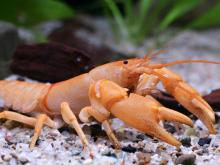
Species Types
Scientific Name
Cambarus hubbsi
Description
Hubbs' crayfish is powerfully built, olive tan or reddish brown, with a narrow blackish band where the carapace and abdomen join. It has a limited range within the Ozarks of southern Missouri and northern Arkansas.
Media
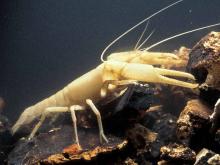
Species Types
Scientific Name
Cambarus setosus
Description
The bristly cave crayfish is a whitish crayfish with small, unpigmented eyes and long, slender pincers with noticeable setae (bristles). It lives in caves in the Springfield Plateau region of the Ozarks.
Media
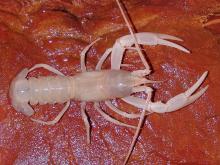
Species Types
Scientific Name
Orconectes stygocaneyi
Description
One of three species of cave crayfish in Missouri, the Caney Mountain cave crayfish is known from only one location. Like many other cave invertebrates, this species is whitish and is blind.
Media
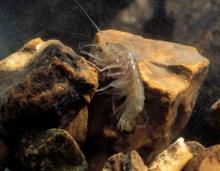
Species Types
Scientific Name
Species in the crustacean order Amphipoda
Description
Often overlooked by people, but eagerly sought by fish, Missouri’s amphipods resemble shrimplike sowbugs. Scuds live in various aquatic habitats, and several species inhabit caves.
Media

Species Types
Scientific Name
Faxonius punctimanus (formerly Orconectes punctimanus)
Description
The spothanded crayfish is moderately large and usually has a noticeable black spot on each pincer near the base of the movable finger. In Missouri, it is found mostly in Ozark waterways in the southeastern quarter of the state, from Callaway, Montgomery, and Warren counties south.
Media

Species Types
Scientific Name
Faxonius immunis (formerly Orconectes immunis)
Description
The calico crayfish is rather plain: gray-green with a pale central zone along the middle of the carapace and abdomen. The pincers are orange-tipped, and in mature males are tinged with purple. It is usually only found in the northern half of the state.
Media
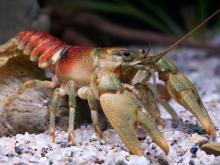
Species Types
Scientific Name
Faxonius eupunctus (formerly Orconectes eupunctus)
Description
The coldwater crayfish has a very localized distribution in the Eleven Point River system. It is stout, with a blue-green head and pincers and dark, rust-brown carapace. It is an imperiled species.
Media

Species Types
Scientific Name
Faxonius longidigitus (formerly Orconectes longidigitus)
Description
The longpincered crayfish is large and colorful, with very long, slender, blue-green pincers that are studded with prominent yellowish knobs. It is restricted to the White River basin in the Ozarks.
Media

Species Types
Scientific Name
Faxonius marchandi (formerly Orconectes marchandi)
Description
The Mammoth Spring crayfish has a very localized distribution: In our state, it lives only in the Warm Fork of Spring River, in Oregon County. It is reddish brown, and its broad, powerful pincers have numerous blackish specks on their basal parts.
Media
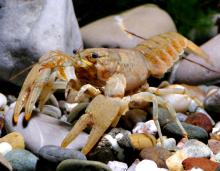
Species Types
Scientific Name
Faxonius williamsi (formerly Orconectes williamsi)
Description
Williams' crayfish is small and rather plain, without bright colors or bold markings. It has a pale, vase-shaped zone along the middle of the dark olive-tan carapace. It is found only in the upper White River drainage of Missouri and Arkansas.
See Also
About Aquatic Invertebrates in Missouri
Missouri's streams, lakes, and other aquatic habitats hold thousands of kinds of invertebrates — worms, freshwater mussels, snails, crayfish, insects, and other animals without backbones. These creatures are vital links in the aquatic food chain, and their presence and numbers tell us a lot about water quality.





















